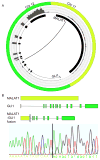Recurrent MALAT1-GLI1 oncogenic fusion and GLI1 up-regulation define a subset of plexiform fibromyxoma
- PMID: 27101025
- PMCID: PMC5586099
- DOI: 10.1002/path.4730
Recurrent MALAT1-GLI1 oncogenic fusion and GLI1 up-regulation define a subset of plexiform fibromyxoma
Abstract
Plexiform fibromyxomas are rare neoplasms, being officially recognized as a distinct entity among benign mesenchymal gastric tumours in the 2010 WHO Classification of Tumours of the Digestive System. Characteristically, these tumours have a multinodular/plexiform growth pattern, and histologically contain variably cellular areas of bland myofibroblastic-type spindle cells embedded in an abundant myxoid matrix, rich in capillary-type vessels. As yet, the molecular and/or genetic features of these tumours are unknown. Here we describe a recurrent translocation, t(11;12)(q11;q13), involving the long non-coding gene metastasis-associated lung adenocarcinoma transcript 1 (MALAT1) and the gene glioma-associated oncogene homologue 1 (GLI1) in a subgroup of these tumours. The presence of the fusion transcript in our index case was confirmed using polymerase chain reaction (PCR) on genomic DNA, followed by Sanger sequencing. We showed that the truncated GLI1 protein is overexpressed and retains its capacity to transcriptionally activate its target genes. A specific FISH assay was developed to detect the novel MALAT1-GLI1 translocation in formalin-fixed, paraffin-embedded (FFPE) material. This resulted in the identification of two additional cases with this fusion and two cases with polysomy of the GLI1 gene. Finally, immunohistochemistry revealed that the GLI1 protein is exclusively overexpressed in those cases that harbour GLI1/12q13 genomic alterations. In conclusion, overexpression of GLI1 through a recurrent MALAT1-GLI1 translocation or GLI1 up-regulation delineates a pathogenically distinct subgroup of plexiform fibromyxomas with activation of the Sonic Hedgehog signalling pathway. Copyright © 2016 Pathological Society of Great Britain and Ireland. Published by John Wiley & Sons, Ltd.
Keywords: GLI1; MALAT1; oncogenic fusion; plexiform fibromyxoma.
Copyright © 2016 Pathological Society of Great Britain and Ireland. Published by John Wiley & Sons, Ltd.
Conflict of interest statement
Conflict of interest: The authors declare no conflicts of interest.
Figures





Similar articles
-
[Clinicopathologic features of gastric plexiform fibromyxoma].Zhonghua Bing Li Xue Za Zhi. 2018 Apr 8;47(4):258-262. doi: 10.3760/cma.j.issn.0529-5807.2018.04.006. Zhonghua Bing Li Xue Za Zhi. 2018. PMID: 29690664 Chinese.
-
Gastroblastoma harbors a recurrent somatic MALAT1-GLI1 fusion gene.Mod Pathol. 2017 Oct;30(10):1443-1452. doi: 10.1038/modpathol.2017.68. Epub 2017 Jul 21. Mod Pathol. 2017. PMID: 28731043
-
Loss of the PTCH1 tumor suppressor defines a new subset of plexiform fibromyxoma.J Transl Med. 2019 Jul 30;17(1):246. doi: 10.1186/s12967-019-1995-z. J Transl Med. 2019. PMID: 31362756 Free PMC article.
-
GLI1, CDK4, and MDM2 Co-Amplification Gastric Plexiform Fibromyxoma: A Case Report and Literature Review.Genes Chromosomes Cancer. 2024 Nov;63(11):e70005. doi: 10.1002/gcc.70005. Genes Chromosomes Cancer. 2024. PMID: 39535850 Review.
-
[Gastric tumors with GLI1 gene alterations (plexiform fibromyxoma and gastroblastoma). Case report and literature review].Arkh Patol. 2025;87(1):37-40. doi: 10.17116/patol20258701137. Arkh Patol. 2025. PMID: 39943727 Review. Russian.
Cited by
-
Integrated diagnosis based on transcriptome analysis in suspected pediatric sarcomas.NPJ Genom Med. 2021 Jun 15;6(1):49. doi: 10.1038/s41525-021-00210-y. NPJ Genom Med. 2021. PMID: 34131151 Free PMC article.
-
Gastroblastoma in Adulthood-A Rarity among Rare Cancers-A Case Report and Review of the Literature.Case Rep Pathol. 2019 Nov 28;2019:4084196. doi: 10.1155/2019/4084196. eCollection 2019. Case Rep Pathol. 2019. PMID: 31871808 Free PMC article.
-
Pediatric plexiform fibromyxoma: A PRISMA-compliant systematic literature review.Medicine (Baltimore). 2019 Jan;98(3):e14186. doi: 10.1097/MD.0000000000014186. Medicine (Baltimore). 2019. PMID: 30653169 Free PMC article.
-
Hepatocellular adenoma in the paediatric population: Molecular classification and clinical associations.World J Gastroenterol. 2020 May 21;26(19):2294-2304. doi: 10.3748/wjg.v26.i19.2294. World J Gastroenterol. 2020. PMID: 32476794 Free PMC article. Review.
-
A Distinct Malignant Epithelioid Neoplasm With GLI1 Gene Rearrangements, Frequent S100 Protein Expression, and Metastatic Potential: Expanding the Spectrum of Pathologic Entities With ACTB/MALAT1/PTCH1-GLI1 Fusions.Am J Surg Pathol. 2018 Apr;42(4):553-560. doi: 10.1097/PAS.0000000000001010. Am J Surg Pathol. 2018. PMID: 29309307 Free PMC article.
References
-
- Takahashi Y, Shimizu S, Ishida T, et al. Plexiform angiomyxoid myofibroblastic tumor of the stomach. Am J Surg Pathol. 2007;31:724–728. - PubMed
-
- Miettinen M, Makhlouf HR, Sobin LH, et al. Plexiform fibromyxoma: a distinctive benign gastric antral neoplasm not to be confused with a myxoid GIST. Am J Surg Pathol. 2009;33:1624–1632. - PubMed
-
- Yoshida A, Klimstra DS, Antonescu CR. Plexiform angiomyxoid tumor of the stomach. Am J Surg Pathol. 2008;32:1910–1912. author reply 1912–1913. - PubMed
Publication types
MeSH terms
Substances
Grants and funding
LinkOut - more resources
Full Text Sources
Other Literature Sources
Medical
Research Materials

